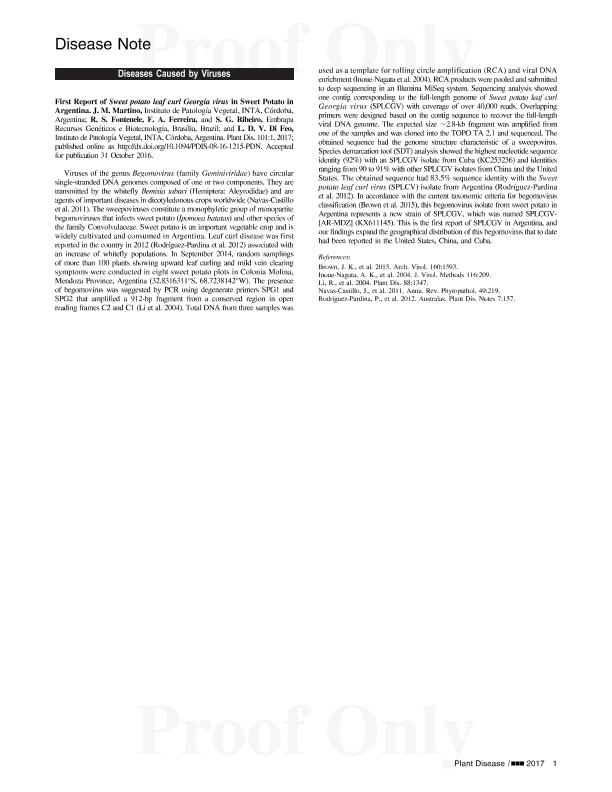Artículo
First report of sweet potato leaf curl Georgia virus in sweet potato in Argentina
Martino, Julia Andrea ; Fontenele, R. S.; Ferreira, F. A.; Ribeiro, S. G.; Di Feo, Liliana del Valle
; Fontenele, R. S.; Ferreira, F. A.; Ribeiro, S. G.; Di Feo, Liliana del Valle
 ; Fontenele, R. S.; Ferreira, F. A.; Ribeiro, S. G.; Di Feo, Liliana del Valle
; Fontenele, R. S.; Ferreira, F. A.; Ribeiro, S. G.; Di Feo, Liliana del Valle
Fecha de publicación:
03/2017
Editorial:
American Phytopathological Society
Revista:
Plant Disease
ISSN:
0191-2917
Idioma:
Inglés
Tipo de recurso:
Artículo publicado
Clasificación temática:
Resumen
Viruses of the genus Begomovirus (family Geminiviridae) have circular single-stranded DNA genomes composed of one or two components. They are transmitted by the whitefly Bemisia tabaci (Hemiptera: Aleyrodidae) and are agents of important diseases in dicotyledonous crops worldwide (Navas-Castillo et al. 2011). The sweepoviruses constitute a monophyletic group of monopartite begomoviruses that infects sweet potato (Ipomoea batatas) and other species of the family Convolvulaceae. Sweet potato is an important vegetable crop and is widely cultivated and consumed in Argentina. Leaf curl disease was first reported in the country in 2012 (Rodríguez-Pardina et al. 2012) associated with an increase of whitefly populations. In September 2014, random samplings of more than 100 plants showing upward leaf curling and mild vein clearing symptoms were conducted in eight sweet potato plots in Colonia Molina, Mendoza Province, Argentina (32.8316311°S, 68.7238142°W). The presence of begomovirus was suggested by PCR using degenerate primers SPG1 and SPG2 that amplified a 912-bp fragment from a conserved region in open reading frames C2 and C1 (Li et al. 2004). Total DNA from three samples was used as a template for rolling circle amplification (RCA) and viral DNA enrichment (Inoue-Nagata et al. 2004). RCA products were pooled and submitted to deep sequencing in an Illumina MiSeq system. Sequencing analysis showed one contig corresponding to the full-length genome of Sweet potato leaf curl Georgia virus (SPLCGV) with coverage of over 40,000 reads. Overlapping primers were designed based on the contig sequence to recover the full-length viral DNA genome. The expected size ∼2.8-kb fragment was amplified from one of the samples and was cloned into the TOPO TA 2.1 and sequenced. The obtained sequence had the genome structure characteristic of a sweepovirus. Species demarcation tool (SDT) analysis showed the highest nucleotide sequence identity (92%) with an SPLCGV isolate from Cuba (KC253236) and identities ranging from 90 to 91% with other SPLCGV isolates from China and the United States. The obtained sequence had 83.5% sequence identity with the Sweet potato leaf curl virus (SPLCV) isolate from Argentina (Rodríguez-Pardina et al. 2012). In accordance with the current taxonomic criteria for begomovirus classification (Brown et al. 2015), this begomovirus isolate from sweet potato in Argentina represents a new strain of SPLCGV, which was named SPLCGV- [AR-MDZ] (KX611145). This is the first report of SPLCGV in Argentina, and our findings expand the geographical distribution of this begomovirus that to date had been reported in the United States, China, and Cuba.
Palabras clave:
Geminiviridae
,
Sweet Potato
,
Ngs
Archivos asociados
Licencia
Identificadores
Colecciones
Articulos(CCT - CORDOBA)
Articulos de CTRO.CIENTIFICO TECNOL.CONICET - CORDOBA
Articulos de CTRO.CIENTIFICO TECNOL.CONICET - CORDOBA
Citación
Martino, Julia Andrea; Fontenele, R. S.; Ferreira, F. A.; Ribeiro, S. G.; Di Feo, Liliana del Valle; First report of sweet potato leaf curl Georgia virus in sweet potato in Argentina; American Phytopathological Society; Plant Disease; 101; 3; 3-2017; 1-1
Compartir
Altmétricas



